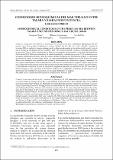Por favor, use este identificador para citar o enlazar este ítem:
https://hdl.handle.net/20.500.12958/3586| Título : | Condiciones hidroquímicas del mar peruano entre Talara y Bahía Independencia. Crucero 1908-09 |
| Otros títulos : | Hydrochemical conditions of the Peruvian sea between Talara and Independencia Bay. Cruise 1908-09 |
| Autor : | Flores, Georgina Carhuapoma, Wilson Beltrán, Luis Domínguez, Noel Sarmiento, Miguel |
| Palabras clave : | Condiciones Hidroquímicas;Mar Peruano;Anchoveta;Bahía Independencia |
| Fecha de publicación : | sep-2021 |
| Editorial : | Instituto del Mar del Perú |
| Citación : | Flores G, Carhuapoma W, Beltrán L, Domínguez N, Sarmiento M. 2021. Condiciones hidroquímicas del mar peruano entre Talara y Bahía Independencia. Crucero 1908-09. Inf Inst Mar Perú. 48(3): 438-450 |
| Citación : | Informe IMARPE;48(3), 2021 |
| Resumen : | Durante el invierno 2019, se realizó el crucero estimación de la biomasa desovante de la anchoveta (Engraulis ringens) por el método de producción de huevos (MPH) 1908 – 09 a bordo de los BIC J. Olaya y Humboldt, abarcando el área entre Talara y bahía Independencia. Este crucero permitió monitorear las condiciones hidroquímicas del invierno 2019. Altas concentraciones de nutrientes (silicatos y nitratos) mayores a 5 µM se observaron en
las aguas superficiales de toda el área de estudio, debido al impacto del afloramiento costero y la presencia de mezcla de Aguas Costeras Frías (ACF) con Aguas Subtropicales Superficiales (ASS). El paso de ondas Kelvin frías favoreció una nutriclina más somera y el incremento de nutrientes en agosto y setiembre. La iso-oxígena superficial de 5 mL/L delimitó el área de mayor concentración de oxígeno, valores mayores (5,5
mL/L) estuvieron relacionadas con las ASS que tuvieron fuerte penetración hacia la costa al sur de Huarmey. La distribución vertical de la zona de mínima de oxígeno se encontró por encima de los 200 m en Paita y Punta La Negra y más superficial en Chimbote, Callao y Pisco reflejando condiciones de afloramiento que determinan una distribución más somera de las aguas deficientes en oxígeno. ABSTRACT: The cruise 1908-09 took place onboard R/Vs Olaya and Humboldt in winter 2019. We aimed to estimate the anchoveta (Engraulis ringens) spawning biomass by the egg production method (EPM). The cruise covered an area between Talara and Independencia Bay. Nutrient concentrations greater than 5 µM were observed throughout the study area due to the impact of the coastal upwelling and the presence of mixing waters (Cold Coastal Waters + Subtropical Surface Waters). In the same period, the arrival of cold Kelvin waves occurred, thus favoring shallower nutrition and increasing nutrients. The surface 5 mL/L iso-oxygen delimited the area with the highest oxygen concentration that was related to the SSWs that had strong coastward penetration to the south of Huarmey. The vertical distribution of the oxygen minimum zone was found above 200 m in Paita and Punta La Negra, while it was shallower in Chimbote, Callao, and Pisco, thus reflecting the upwelling conditions that allow the shallower distribution of hypoxic waters. |
| URI : | https://hdl.handle.net/20.500.12958/3586 |
| ISSN : | 0378-7702 |
| Aparece en las colecciones: | Informe vol. 48(3) 2021 |
Ficheros en este ítem:
| Fichero | Descripción | Tamaño | Formato | |
|---|---|---|---|---|
| Informe 48-3 articulo10.pdf | 11,21 MB | Adobe PDF |  Visualizar/Abrir |
Este ítem está sujeto a una licencia Creative Commons Licencia Creative Commons

